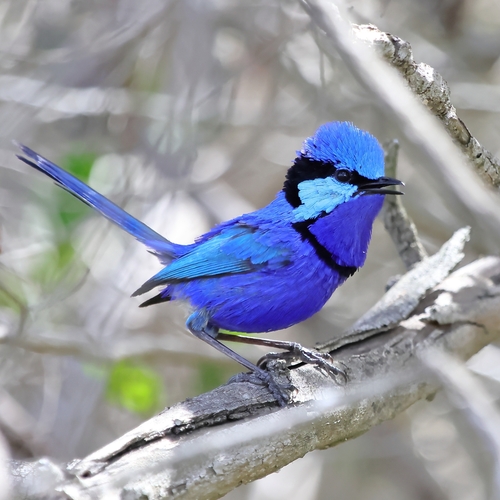
Splendid Fairywren
The Splendid Fairywren (*Malurus splendens*) is a small, strikingly colored bird native to Australia. Known for the brilliant iridescent blue plumage of breeding males, these birds are a common sight in many parts of the continent. They play a vital role in their ecosystems as insectivores, helping to control insect populations. Splendid Fairywrens are also culturally significant, often appearing in Australian folklore and art, and are appreciated for their beauty and lively behavior.
11.5-13.5 cm
Length
15-18 cm
Wingspan
Least Concern
Conservation Status
Distribution
The Splendid Fairywren is widespread across much of Australia, excluding the far northern tropical regions and Tasmania. They are found from coastal areas to inland arid zones, with different subspecies occupying different regions. They do not undertake long-distance migrations, but may make local movements in response to food availability or rainfall.
Lifespan
Average lifespan in the wild is 4-6 years, but some individuals can live up to 8 years.
Splendid Fairywren's Habitat
Habitat Types
Woodlands, Shrublands, Mallee, Heaths, Open forests with dense understory
Climate Zones
Temperate, Subtropical, Arid, Semi-arid
Adaptations
Splendid Fairywrens are well-adapted to arid and semi-arid environments. They can obtain much of their water needs from their insect prey, reducing their reliance on open water sources. Their dense plumage also provides insulation against temperature extremes.
Variations
Several subspecies are recognized, including *Malurus splendens splendens* (inland and southwestern Australia), *Malurus splendens musgravi* (central Australia), and *Malurus splendens callainus* (coastal Western Australia). These subspecies differ slightly in plumage coloration and size.
Appearance
Breeding Plumage
Breeding males have brilliant iridescent blue, violet, and black plumage. Non-breeding males, females, and juveniles are predominantly brown and buff, with blue coloration often remaining on the wings and tail.
Seasonal Feather Changes
Males molt into their breeding plumage before the breeding season and revert to a more cryptic non-breeding plumage after breeding.
Sex Based Plumage Differences
Highly pronounced. Breeding males are brightly colored, while females and non-breeding males are much duller.
Notable Features
Brilliant iridescent blue plumage in breeding males., Long tail, often held upright., Small, rounded wings., Short, slender bill.
Diet and Feeding
Primary Foods
Insects, Spiders, Other small arthropods, Occasionally seeds and fruits
Foraging Behavior
Splendid Fairywrens forage actively on the ground and in low vegetation. They hop and flit through the undergrowth, gleaning insects from leaves and branches. They may also forage in small groups.
Specializations
Their small, pointed bill is well-suited for picking insects from crevices and foliage. They have strong legs and feet for hopping and navigating dense vegetation.
Seasonal Diet Variations
Diet may shift slightly depending on the availability of insects. During periods of insect scarcity, they may consume more seeds and fruits.
Behavior
Social Structure
Splendid Fairywrens live in cooperative family groups, consisting of a dominant breeding pair and several helpers, usually their offspring. These groups defend a territory year-round.
Communication
High-pitched, trilling calls, Visual displays, including wing fluttering and tail cocking, Petal carrying during courtship
Migration
Splendid Fairywrens are generally sedentary, not undertaking long-distance migrations. However, local movements may occur in response to resource availability.
Territorial or Group Behaviors
Family groups are highly territorial, defending their territory against other fairywren groups. Within the group, a dominance hierarchy exists, with the breeding pair being dominant.
Conservation
Threats
Habitat loss and fragmentation due to agriculture and urbanization, Predation by introduced species (cats, foxes), Increased frequency and intensity of wildfires due to climate change
Protection Programs
Habitat restoration and protection initiatives, Control programs for introduced predators, Monitoring of populations
Local National Laws
Protected under various state and national wildlife legislation in Australia.
Population Trend
Stable
Population Estimates
While precise estimates are difficult, the species is considered common and widespread.
Interesting Facts
Cooperative Breeding
Splendid Fairywrens are cooperative breeders, meaning that offspring from previous broods often stay with their parents to help raise subsequent broods.
Petal Carrying
Male Splendid Fairywrens are known for carrying brightly colored petals, often yellow or red, as part of their courtship display to attract females.
High Extra-Pair Paternity
Despite forming socially monogamous pairs, studies have shown that Splendid Fairywrens have high rates of extra-pair paternity, meaning that females often mate with males outside of their social group.
Faqs about Splendid Fairywren
What do Splendid Fairywrens eat?
They primarily eat insects, spiders, and other small arthropods. They may also occasionally consume seeds and fruits.
Where do Splendid Fairywrens live?
They are found across much of Australia, inhabiting woodlands, shrublands, and other areas with dense undergrowth.
Are Splendid Fairywrens endangered?
No, they are currently classified as Least Concern by the IUCN, meaning they are not considered to be at risk of extinction.
Why are male Splendid Fairywrens so brightly colored?
The bright blue plumage of breeding males is used to attract females during courtship. This bright coloration signals good health and genetic quality.
Copyright @ Nature Style Limited. All Rights Reserved.
 English
English